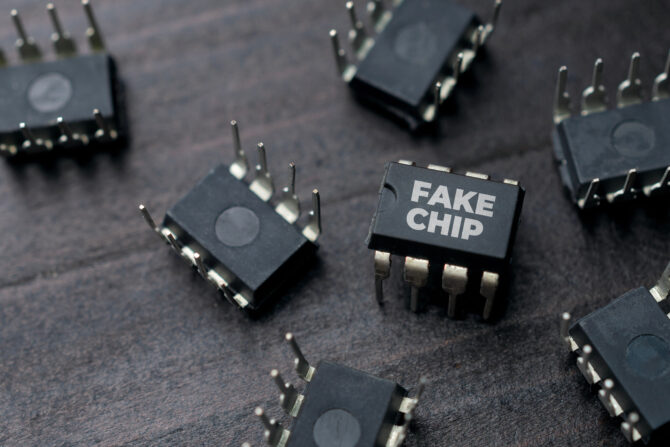
Buying counterfeit parts: The risks are real
By Kevin Parmenter, director of field applications engineering, Taiwan Semiconductor
Electronics Supply Chain components counterfeit distribution Editor Pick fake parts semiconductor supply Chain TaiwanAn industry expert offers advice on how to avoid buying fake components
Due to the semiconductor industry’s global supply chain issues the risk of buying counterfeit devices is high. When fake parts make it into end products, rather than being quarantined and eliminated during production, the repercussions are costly. Field failures, service calls, RMAs, loss of reputation and legal exposure – all are likely results. Buyers need to avoid buying fake parts from an unauthorized source, not through the established supply chain, and then realizing, too late, that the parts broker – and your money – is long gone.
How did we get here?
The electronics industry is a cyclical business. I have personally witnessed many down cycles in the semiconductor industry; the first in 1984. A consistent theme, noticed by those of us who have seen this movie before, is that newer colleagues tend to ignore our warnings and advice. The truth is that most downturns are self-inflicted.

Source: Adobe Images
One problem is that our industry is obsessed with forecasting. This reliance on data to predict future consumer buying trends is primarily used by organizations to placate investors and/or upper management. The dirty little secret is that the industry is basically a build-to-order business. We buy parts based on what we think might happen down the line. As a consumer, when was the last time you set out to buy a refrigerator or big screen TV and told the salesperson that you would be back in six months to place an order on X and Y date? Yet, the industry bases our inventory on a similar fantasy.
Another problem is that we have no elasticity in the system. In the old days, the supply chain could rely on “buffer stock” inventory of finished goods, parts, raw materials, and so on. I recently listened to a professor from a prestigious university give an honest assessment of what happened during the automotive supply chain shutdown. For the last 30-plus years, she explained, business schools have taught JIT (just in time) and lean manufacturing and, as a result, component makers, distributors, OEMs, contract manufacturers, and the like, hire people trained in these “inventory bad” concepts. Everyone in the supply chain passes the problem onto the next person in the chain with the attitude: “We are paying you, so you should fix it for us.”
The casino mentality
Most electronics OEM buyers are essentially salespeople in reverse. They often buy at the lowest possible price, with minimum risk and commitment to the organization. During a downturn, the usual 4-8-week lead-time ARO can go to controlled-order-entry (or allocation, which we used to call it). This means that lead times can go to up to 99 weeks, the maximum time software systems allow. When this happens, salespeople who experienced the last industry down cycle have probably moved on. The new, inexperienced buyer usually goes into deer-in-the-headlights mode, thinking it is some kind of trick of the suppliers. Valuable time is wasted in denial rather than solving the problem.
Other buyer behaviour that I have seen over the years is doing things during normal supply chain activity that makes the organization less attractive to the suppliers, such as constantly telling them that their prices are too high and delivery is too long. If they partake in shenanigans year after year, these buyers will be the last to be taken care of by annoyed suppliers when a downturn occurs.
This is where the opportunity arises for the counterfeit supplier. The panicked buyer starts contacting everyone who has ever made or sold an electronic component asking for pricing and delivery. This is what I call casino mentality: “If I just pull this lever enough times, the next one will pay off big.”
At this point, the unauthorized broker is ready to tell the buyer exactly what they want to hear: They have the perfect parts. Stock is set aside at a good price. We can ship them to you. In response, an experienced buyer might realize that things are too good to be true. But if the buyer is inexperienced, their need for the delivery might overcome even prices they don’t like. All they can think is “Ding-ding-ding, I hit the payoff.”
Now we see the sophistication of the counterfeit parts brokers. If the buyer says, “Send us some to test,” the broker will either refuse or they will send some actual parts for the buyer to test. In a typical scenario, the target customer might be looking for, say, precision op amps and the buyer will request a reel to prove out. They will probably receive some type of op amp showing rudimentary testing, or the first few feet of the reel will be the real thing.
The goal of course will be to get the buyer to give an order for the entire quantity. Rather than accepting a PO, the broker will only take a check that must be cashed before the total number of needed parts will be sent. The shipment will be op amps marked with the desired part number and logo, or some sort of IC with a die marked with the desired info.
By the time the buyer discovers that the shipment is bad, the broker will have morphed into something else and can’t be contacted. Perpetuating the problem is that buyers of counterfeit items don’t want to admit they were duped into wasting thousands of dollars of their company’s money. The transaction is often swept under the rug and never discussed again.
What to look for
No one knows how big a problem counterfeit electronics are, but we do know it’s more prevalent than ever. And that the counterfeiters and brokers are getting more sophisticated all the time. What electronic components are counterfeited? Semiconductors, capacitors, connectors – anything and everything. The parts can be the wrong part but marked with the information the buyer is looking for. Or they can have no die, the wrong die or they might even be “reject” parts from the right supplier.
Many people don’t know or understand that buyers of counterfeit products are not immune to legal exposure. In most countries in the world, it’s illegal to possess counterfeit products and entities can be sued because they bought and or possess the counterfeit products. Laws and recourse differ in various areas of the world; in some countries, it seems as if counterfeiting is treated as an honourable profession. All this considered, it’s odd that don’t we hear more about the problem of counterfeit parts than we do.
So, as a customer buying parts, what can you do to avoid buying fakes, and what are the red flags to watch for?
First and foremost, don’t buy from unauthorized sources. Authorized distributors go to great lengths to make sure they have systems and certifications in place to make sure no counterfeit materials enter their supply chains, including quarantining returns until they are validated so that no inventory is contaminated. The authorized channels also maintain certifications and adherence to processes and policies, which are designed to make sure only authorized products are maintained. I have never had or heard of a counterfeit situation occurring when parts are bought from authorized distributors.
Red Flag 1 – Touting perfect inventory quantities. Be suspect if the number of parts that the source has in stock is coincidentally the same as the amount you need. Or if it seems that no one else has the parts except for this outfit.
Red Flag 2 – Language issues. As opposed to most mainstream part makers, counterfeiters often do not have the resources to rely on personnel where English is their primary language. If you see an inordinate amount of grammar and spelling mistakes – and no attempt to correct them – you maybe be talking to an unauthorized broker from a far-off land.
Red Flag 3 – Buyer’s hesitation to confirm authenticity. If you are in any doubt, don’t hesitate to contact the actual manufacturer of the parts and ask them to validate the source – before you make a strategic mistake.
Conclusion
What is interesting about this current down cycle is that it has lasted for years not months, and that it resulted from the covid pandemic combined with the Russian invasion of Ukraine. More than ever, savvy counterfeit parts brokers are taking advantage of the situation.
What remains to be seen is if this cycle will change misguided inventory and buying practices, dating back decades. Can we go back to keeping inventory buffer stock, or can we teach new staff the lessons learned by managing previous downturns, or can we try new technologies like blockchain?
What I do believe is that these up/down industry cycles will likely continue for generations.
———————————————-
About the Author
Kevin Parmenter is director of field applications engineering for Taiwan Semiconductor, North America. With over 35 years of experience in the electronics and semiconductor industry, his expertise includes technology marketing, applications engineering, product definition, as well as design engineering for the medical electronics and military electronics fields. He has a BSEE from Purdue University and a BS in Business Administration from Colorado Technical University.

